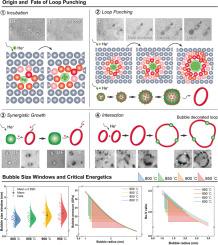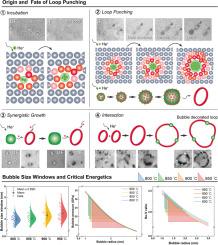Mo-5Re 合金中环冲孔的起源和命运
IF 8.3
1区 材料科学
Q1 MATERIALS SCIENCE, MULTIDISCIPLINARY
引用次数: 0
摘要
环冲孔是晶格膨胀的基本物理过程,它是由于在结晶金属中引入了不溶性气体原子,导致间隙原子释放,甚至形成棱柱位错环,从而主导了材料的降解。尽管经过了半个多世纪的研究,但仍然缺乏对其基本过程的实验捕捉,导致已知的机制只能是猜测和推断。在这里,我们首次报告了最清晰、最直接的冲环实验细节,并提出了一种新的机制。根据原位实验,打圈的起源和命运被细化为四个阶段:孵化、打圈、协同生长和相互作用。在温度高于 ∼ 0.4 Tm 时,差排环的成核和生长完全由气泡生长诱导,这为打环提供了直接证据。我们定义并评估了实验检测到的环状冲孔的临界气泡尺寸窗口,结果表明随着温度的升高,临界气泡尺寸窗口变宽,平均值增大,从而进一步量化了环状冲孔所需的临界能量。此外,打孔环的后续命运不仅包括相互凝聚形成超大型环,还包括与邻近气泡的相互作用,在此期间,气泡充当了装饰环边缘的销钉点,并介导其生长。这些结果提供了对环冲孔机制的全面的新认识,并有望促进相关理论的发展。本文章由计算机程序翻译,如有差异,请以英文原文为准。


Origin and fate of loop punching in Mo-5Re alloy
Loop punching is the basic physical process of lattice expansion due to the introduction of insoluble gas atoms into the crystalline metals leading to the emission of interstitial atoms and even the formation of prismatic dislocations loops, which therefore dominate the degradation of the material. Despite more than half a century of research, experimentally capturing its fundamental process is still lacking, resulting in known mechanisms being speculated and inferred. Here, we reported for the first time the clearest and most direct experimental details of loop punching and proposed a new mechanism. According to the in-situ experiment, the origin and fate of loop punching were detailed into four stages: incubation, loop punching, synergetic growth, and interaction. At temperatures above ∼ 0.4 Tm, the nucleation and growth of dislocation loops became completely induced by bubble growth, which provided direct evidence of loop punching. The critical bubble size window for experimentally detectable loop punching was defined and evaluated, showing that it became wider and increased in average value with increasing temperature, which made that the critical energetics required for loop punching were further quantified. Furthermore, the subsequent fate of punched-out loops involved not only their mutual coalescence to form super-large 〈111〉 loops but also interactions with adjacent bubbles, during which the bubbles acted as pinning sites decorating the loop edges and mediating their growth. These results provide a comprehensive new understanding of the loop punching mechanism and promisingly contribute to the development of related theories.
求助全文
通过发布文献求助,成功后即可免费获取论文全文。
去求助
来源期刊

Acta Materialia
工程技术-材料科学:综合
CiteScore
16.10
自引率
8.50%
发文量
801
审稿时长
53 days
期刊介绍:
Acta Materialia serves as a platform for publishing full-length, original papers and commissioned overviews that contribute to a profound understanding of the correlation between the processing, structure, and properties of inorganic materials. The journal seeks papers with high impact potential or those that significantly propel the field forward. The scope includes the atomic and molecular arrangements, chemical and electronic structures, and microstructure of materials, focusing on their mechanical or functional behavior across all length scales, including nanostructures.
 求助内容:
求助内容: 应助结果提醒方式:
应助结果提醒方式:


